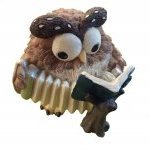-
Posts
380 -
Joined
-
Last visited
Profile Information
-
Gender
Male
-
Interests
Anglo concertina; melodeon/button accordion; traditional dance and vocal music from the USA, Ireland, the UK, France, Québec and other places.
-
Location
USA
Recent Profile Visitors
1,500 profile views
Bob Michel's Achievements

Chatty concertinist (4/6)
-
The layout on my Jeffries is a bit idiosyncratic, but it affords essentially the same options, and I think I use the two fingerings more or less interchangeably. It depends on the phrase. Typically I’ll experiment with both when learning a tune, and as often as not I’ll end up incorporating both variations into the arrangement I eventually come up with. I’ll confess, though, that when I was first learning to play Anglo (on a 40-button Wheatstone layout that included a draw C#) I leaned far too heavily on the draw B in the right hand middle row; it took me an embarrassingly long time (and an extended stint on a 30-button Wheatstone-style instrument) to awaken to the possibilities of the push B on the left. Now they feel equally natural, and I can grab the one that better suits the musical context without having to think about it. Bob Michel Near Philly
-
A guitar—especially with the aid of a capo—is much better suited than an Anglo concertina to playing full chords in all keys. So if you’re playing along with a guitarist, you can consider that duty covered; rather than simply trying to double what s/he is doing, you can explore styles of playing that apply the strengths of your own instrument. While big chords certainly have their place, I think the Anglo’s real forte is understatement: less is usually more. With a guitarist on board, someone else is doing the heavy lifting, and you’re free to fool around. Instead of trying to duplicate that booming E chord, try doubling the melody, or improvising from it. Or work out a single-note harmony line. Or invent a lovely countermelody. Or alternate a simple drone harmony (one or two notes) with runs and fills. We have no capos, so every key will be different, and the further you stray from your home keys of C and G the weirder and more challenging your scales and chords will become. But it’s always possible, and it’s always interesting. Bob Michel Near Philly
-

Accordion Reed v Concertina Reed
Bob Michel replied to Ann Sanders's topic in General Concertina Discussion
Like Jim, I tend to prefer the timbre of traditional reeds. But a well-made hybrid can sound gorgeous. I’m particularly fond of concertina duets, and to my ear (for whatever it’s worth) there’s something downright magical about the two types working together. I often get to play along with a Morse, a Tedrow, an Edgley and/or a Herrington. No two of them sound at all alike, but each of them complements my Jeffries wonderfully. Hybrids may have originated as a practical compromise, but at this point I think the concertina soundscape is much the richer for them. Bob Michel Near Philly -
I play 38- and 40- button Anglos, but none of them has a low D. They all have the luxury of a drone button, though, and that’s where I’d think about putting the low D (presumably on the draw) if I wanted that note. Speaking for myself, I’d miss the low F, even though I rarely use it for Irish tunes. The full F chord just has a distinctively lovely sound. On the other hand, full, deep chords in any key have a pretty limited role in the sorts of Irish playing I like, and when I want them I’m happy to make do with what I have, just as a piper makes do with the available notes on the regulators. Working within (or around) limitations like that is an aspect of the music I find enjoyable. Tastes vary, though, and there’s no reason not to pursue an innovation if it appeals to you. No doubt you’ll want to make sure any layout changes are reversible, though, in the event your preferences change down the road, or in case you someday decide to sell the instrument. Bob Michel Near Philly
- 10 replies
-
- anglo
- wheatstone
-
(and 8 more)
Tagged with:
-
Welcome to the concertina. In theory you can learn on a D/A instrument as easily as on a C/G: just treat it as a transposing instrument and play *as if* it were a C/G. The fingerings you use will produce a different pitch, but thats not critical if youre playing strictly by yourself. However, as soon as you want to play with another musicianincluding any recordings in whatever instructional materials you use, YouTube videos, etc.you'll want to be in the same key as s/he is. For that reason the more common C/G instrument may well be more practical, even in the early going. The important thing is just to get started, and any of the makes you mention, assuming its in good shape, would suffice to learn the basics. One you dont mention, the Rochelle by Concertina Connection, would be my pick in that price range. Its plastic and Chinese, I suppose, but well designed and built. Several of my students have started out on them, and they're very serviceable instruments. Bob Michel Near Philly P.S. Sorry about the missing punctuation in that answer; the text editor is removing it for some reason, and I cant seem to replace it.
-
I’m obviously not a top player, and I prefer 38- or 40-button instruments. But I do play mostly Irish music, and for what it’s worth I’m a fan of the Wheatstone system—to the point of being delighted, when I bought my Jeffries a couple of years ago, that it had an unusual Wheatstone-esque layout. I appreciate the symmetry of the two octaves in the Wheatstone arrangement. I also have a lazy tendency to fall into long-winded, legato phrasing, and having to play right hand C# on the push serves as a useful speed bump and makes me play more thoughtfully. Of course, 40-button Wheatstone-style boxes do have a draw option for that pesky C#; in fact my Wheatstone has two. The default position for the note is the top button on the left-hand C row. I can’t imagine a better place for it. Bob Michel Near Philly
-

World War One Concertina : Another Possible Book ?
Bob Michel replied to Terence's topic in Tunes /Songs
I spent the better part of a year exploring this repertoire not too long ago. Here’s the YouTube playlist: https://www.youtube.com/playlist?list=PLGBWgBMt3xfeh1ox7Hp-3d32PGAeIPaxH And here’s the discussion thread, with documentation for all the songs, that accompanied it on this site: http://www.concertina.net/forums/index.php?showtopic=17935 There are plenty of omissions, as my choices were skewed toward Tin Pan Alley (i.e., American) songs of the period, whether war-themed or not. But I tried to strike a balance between familiar chestnuts and more obscure numbers, to give a sense of what people were singing on this side of the Atlantic, at any rate, in the teens of the last century. I had a lot of fun working up (Anglo) concertina arrangements for the songs. Enjoy! Bob Michel Near Philly -
Ben's Wheatstone looks very similar to mine (though mine's a hexagonal 6A model, from '53). I just want to put in a word for how nice these sometimes maligned postwar instruments can be. I've never found the eight-fold bellows or extra buttons to be an impediment to playing fast Irish tunes (probably thanks to the aluminum reed shoes, the box is very lightweight), and they're very positive features when you're playing in an odd key, or accompanying a singer. I eventually had the Button Box install a riveted action in mine, but it saw heavy session duty for years before that and never had any trouble keeping up. I have no interest in the sale; just wanted to share my experience. The Buy It Now price seems very reasonable, and if it's as nice as it looks this could be a great step up for someone, and a very satisfying, versatile concertina. Bob Michel Near Philly
-

Mellow Concertinas - Mid Range
Bob Michel replied to DaveLimerick's topic in General Concertina Discussion
I like this way of thinking about it. A well made and set up instrument can be played quietly to great effect, with more volume and stridency in reserve for situations where you might want or need it. A Morse (or something similar) would certainly fit the bill. It really is more about the player than the instrument. Bob Michel Near Philly -
Point taken. But if by "tunes from Clare" the OP means 1) some core repertoire associated with that district and 2) the elements of one distinctive regional approach to playing it, that collection, among others, would surely spring to mind. Bob Michel Near Philly
-
Kevin Crehan's wonderful fiddle CD "An Bhábóg sa Bhádóg" (now apparently back in print; it's listed at Custys) would be one great source: it's a compendium of tunes written by or associated with Kevin's grandfather Junior Crehan, including the "Four Stacks," "The Mist-Covered Mountain," "The Hills of Coore," "The Otter's Holt," etc. Mary McNamara's recordings have some lovely sets for concertina: try "John Naughton's" and "The Reel with the Birl," or "The Humours of Tullycrine" and "Mickey Callaghan's Fancy," both from "Traditional Music from East Clare." A lot of Mary's sets (and settings) are drawn from the classic 1959 LP by Paddy Canny, P.J. Hayes, Peadar O'Loughlin and Bridie Lafferty which Shanachie rereleased as "An Historic Recording Of Irish Traditional Music." That album would be a perfect starting point for learning sets of Clare tunes. Bob Michel Near Philly
-
No; me, too. No disparagement of the Jeffries layout intended--I know many people swear by it--but I couldn't easily dispense with that button. Even my Jeffries has one! I've owned both a 30-button C/G and a G/D instrument, but for the range of things I do (Irish trad, song accompaniment in a variety of keys, and anything else that strikes my fancy), a 38- or 40-button C/G seems to work the best. If I were having such an instrument made to my specifications, I'd probably go with the standard Wheatstone layout, as long as it included the draw A on the lowest button of the left-hand G row. Only one of my current boxes (a Wheatstone) has that feature, and I wish they all did. It makes playing an alternating bass in D much easier. You can still do this with only a push A, but it requires a routine bellows reversal that takes some practice. Bob Michel Near Philly
-

High D/e On The Left Or Right ?
Bob Michel replied to mrjubba's topic in General Concertina Discussion
As Chris says, it mostly comes down to phrasing. Example: how would you play a B-c#-d run? If you're using the Wheatstone system (and a 30-button box), you have c# only on the push. So if you want to avoid a bellows reversal--as a fiddler might use a slur, bowing all three notes in the same direction--you're constrained to use the left hand push-d. On the other hand, you might prefer to reverse the bellows in a particular context, just as a fiddler might prefer to reverse the bow. It depends on the sound you're looking for. How you choose to ornament the note is another consideration. I'll typically grace the left hand push-d by very quickly playing two buttons on the right hand (usually e and c) in quick succession to produce a staccato triplet. For the right hand pull-d, I'll usually use the "phantom button" approach, tapping the left side (as opposed to buttons) to get the requisite bounce. The sounds are similar, but not identical. So that's another criterion for choosing one fingering or the other. Finally, it's not an either-or proposition. By all means concentrate on one fingering until it's second nature, but don't hesitate to experiment with the other as well. In the long term, being able to articulate a phrase in two (or more) contrasting ways will add a lot of interest to your playing. And it's more fun. Bob Michel Near Philly -
All other considerations aside, the sentence "I of course replied that under no circumstances could I be a party to such a tryst, and she set about my recording equipment with a burning log." is one I very much wish I'd written. Bob Michel Near Philly
-
The adoption of the C/G Anglo as the standard concertina for Irish traditional music was a historical accident; nothing more. There's nothing about that configuration that makes it particularly easy to mimic piping styles--and anyway, that kind of mimicry is a relatively recent fashion in Irish concertina playing. We owe the cross-row conventions of the "modern" style, and its familiar vocabulary of ornaments, to the ingenuity of the players (Paddy Murphy among others) who figured out how to integrate a concertina into the kind of ensemble playing that became popular as part of the public dance hall scene from the 1930s onward. C/G boxes were used because C/G boxes were available. If they sound more "natural" to us now than, say, G/D instruments, that's just because we're so used to hearing them. Bob Michel Near Philly






